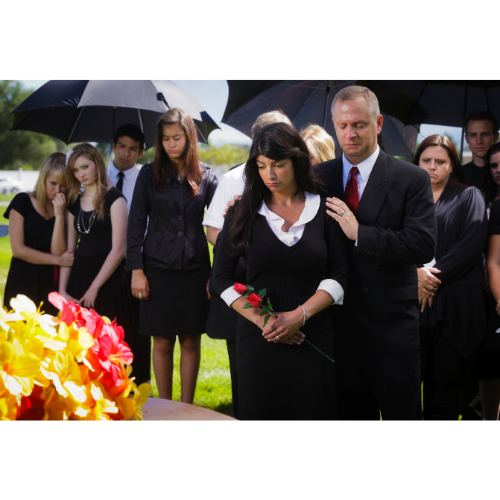The most expensive part of a funeral is often the casket or urn, with prices ranging from a few hundred to thousands of dollars.

Overview of Funeral Expenses
The most expensive components of a funeral often include the casket or urn, funeral service fees, cemetery plot, headstone, and transportation, contributing to the average funeral cost ranging between $7,000 and $12,000. Cremation is a more affordable option, costing between $6,000 and $7,000. Since the 1980s, funeral costs have been on a steady rise, emphasizing the need for cost-saving measures and pre-planning to alleviate the financial burden on family members.
The rising costs of funerals can be attributed to various factors such as the increasing prices of caskets and urns, additional service fees, and the expenses associated with cemetery arrangements. Families often find themselves overspending due to emotional strain, highlighting the importance of price shopping and implementing cost-effective measures to manage the overall expenses. It’s crucial for individuals to explore pre-planning options to ensure that funeral arrangements are made within a financially manageable framework, thus reducing the burden on loved ones during a challenging time.
Moreover, funeral expenses can vary significantly based on the location and the specific services chosen. For example, the north central region of the country tends to have the highest costs for burial, while cremation and burial expenses also differ by state. Understanding these variations can empower individuals to make informed decisions and explore cost-effective alternatives that align with their financial capabilities. By being aware of the different expenses involved in a funeral, individuals can take proactive steps to manage costs effectively and seek out assistance or resources that can provide financial relief.
 The Most Expensive Part: Casket or Urn
The Most Expensive Part: Casket or Urn
The casket or urn is often the most expensive part of a funeral, with prices ranging from a few hundred to thousands of dollars. For instance, a high-end casket made of solid bronze or copper can cost upwards of $10,000, significantly impacting the overall funeral expenses. Families may feel emotionally compelled to select an expensive casket or urn as a way to honor their loved one, which can lead to overspending. Therefore, it’s crucial to explore more affordable options and consider cost-saving alternatives without compromising the significance of the funeral service.
In addition to the casket or urn, other costly components contribute to the overall funeral expenses. These may include embalming, which can cost around $500 to $700, funeral service fees, cemetery plot expenses, headstone or grave marker costs, and transportation fees for the deceased and the family members. Understanding the breakdown of these expenses can help families make informed decisions and explore ways to mitigate the financial burden.
Breakdown of Funeral Expenses
When it comes to funeral expenses, it’s essential to understand the various cost-effective options available. Direct burial or cremation are often more affordable choices for individuals and families. Direct burial typically costs about $2,597, while direct cremation is priced at approximately $2,183. In contrast, the average burial service, complete with a viewing and vault, can cost a significant $9,420, and a cremation with a viewing averages at $6,970. These figures highlight the substantial difference in cost between traditional burial services and cremation options, making it crucial for individuals to carefully consider their preferences and budget.
Funeral expenses encompass a wide range of services and items that contribute to the overall cost. These can include embalming, various cosmetic preparations, facility usage for viewing, funeral home staff for service, hearse, printed memorial package, burial casket, vault, cremation fee, cremation casket, and urn. Understanding the breakdown of these expenses is important for individuals and families as they navigate the process of funeral planning. By being aware of the specific components that contribute to the overall cost, individuals can make informed decisions about which services are essential for their needs and budget, and which ones may be less necessary.
For those who are seeking to make informed and cost-effective choices during the funeral planning process, understanding the breakdown of expenses is crucial. It enables individuals to weigh their options carefully, make decisions that align with their budget, and ultimately ensure that they are able to honor their loved ones in a meaningful way without experiencing unnecessary financial strain.
Cost-Saving Strategies
When it comes to funeral expenses, there are several strategies that can help alleviate the financial burden on families. One of the most effective tips for saving on funeral costs is to request the general price list from multiple funeral homes. This allows individuals to compare prices and services, ensuring they are getting the best value for their money.
Exploring various options is also crucial in saving on funeral costs. This can include considering alternative venues for the funeral service, opting for a graveside service instead of a traditional funeral home service, or choosing a location that doesn’t require expensive facility usage fees. By being open to different options, families can significantly reduce their overall expenses while still honoring their loved ones in a meaningful way.
Another practical cost-saving measure is to consider purchasing a casket or urn separately. In many cases, funeral homes may offer these items at a higher price, and families can often find more affordable options by exploring other vendors or suppliers. By doing so, they can potentially save a substantial amount of money on one of the most expensive components of a funeral.
Furthermore, being open to cost-effective alternatives such as direct cremation or burial can lead to significant savings. Direct burial typically costs about $2,597, while direct cremation is even more affordable at $2,183. These options provide families with a dignified way to lay their loved ones to rest without incurring the higher costs associated with traditional burial services.
Lastly, financial assistance for funeral expenses may be accessible through various avenues, including state and local funding, Medicaid, the Department of Veterans Affairs, Social Security, and the FEMA COVID-19 funeral assistance program. These resources can provide much-needed support to families during a challenging time, helping to ease the financial strain associated with funeral costs.
By implementing these cost-saving strategies and exploring available assistance programs, families can navigate the process of honoring their loved ones with greater financial peace of mind.
Types of Funerals and Consumer Rights
When it comes to funerals, there are various types available to accommodate different preferences and financial situations. For instance, low cost/low income funerals are designed to provide affordable options for those on a tight budget, while horse & carriage funerals offer a traditional and elegant way to honor a loved one. Military funerals are specifically tailored to honor the service of veterans, complete with military honors and rituals. On the other hand, green funerals focus on environmentally friendly practices, such as natural burials and biodegradable caskets, appealing to those with eco-conscious values.
In addition to the diverse types of funerals, consumers have specific rights as outlined in the Funeral Rule. This rule ensures that individuals have access to transparent pricing and options, empowering them to make well-informed decisions during the funeral planning process. By asking relevant questions and understanding their rights, consumers can navigate the challenging and emotional experience of planning a funeral with confidence.
Remember, to learn more about the different types of funerals and consumer rights, visit Best Priced Funerals for comprehensive information and resources to assist you in making informed decisions during the funeral planning process.
 Conclusion and Call to Action
Conclusion and Call to Action
In conclusion, the most expensive part of a funeral is typically the casket or urn, with prices ranging from a few hundred to thousands of dollars. These costs contribute significantly to the average funeral expense, which ranges between $7,000 and $12,000, and has been steadily rising since the 1980s. It’s important for individuals to understand the various components that make up the total cost of a funeral and explore strategies to reduce these expenses.
In addition to the casket or urn, other costly components include embalming, funeral service fees, a cemetery plot, headstone, and transportation. Families often emotionally overspend on funeral arrangements, which emphasizes the importance of price shopping and considering cost-saving measures such as direct burial or cremation, which offer more cost-effective options. Exploring these alternatives can help individuals make informed decisions and alleviate the financial burden on their loved ones.
For comprehensive information and resources on funeral planning, cost-saving tips, and consumer rights, readers are encouraged to explore Best Priced Funerals at Best Priced Funerals. This website provides valuable insights into funeral planning, funeral gifts, caskets, and other related topics, aiming to help individuals make informed decisions during the funeral planning process. By exploring these resources, individuals can gain a better understanding of the options available to them and make choices that align with their budget and preferences.
Check out our YouTube Channel at: https://tinyurl.com/22uefbnj

